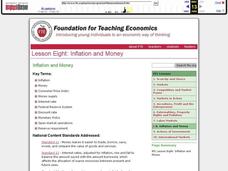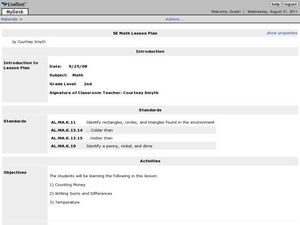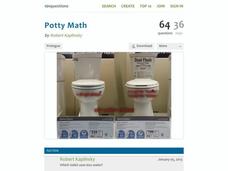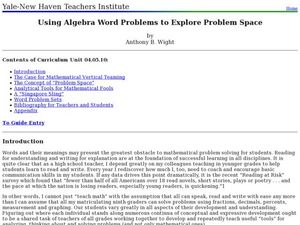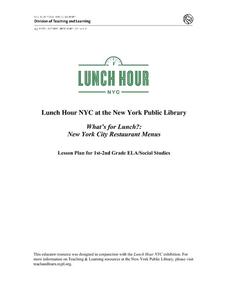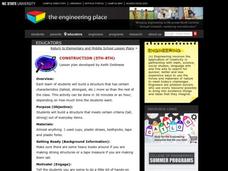Curated OER
Money Math
Is there a better, and more motivating, math manipulative than money? Kids love to use it, and it's a great teaching tool. Here, there are three good activities using coins. Learners create patterns, sort change, and have a...
Curated OER
Inflation and Money
Students examine the relationship between inflation and money. Defining key terms, they define money in terms of its functions and give examples of money. They discover what happens when inflation occurs unexpectedly. They also examine...
Curated OER
Right on the Money
Students are introduced to coins and bills in American currency. After watching a video, they practice making the same amount of money out of different combinations of coins and bills. Using the internet, they discover how much each...
Curated OER
Counting Money Activity
Second graders explore commerce by practicing monetary transactions. In this consumer math instructional activity, 2nd graders practice using math functions to add and subtract different amounts of money. Students identify the different...
Curated OER
ADULT ESOL LESSON PLAN--Concepts of Time and Money
Students identify different denominations of United States currency and symbols associated with money and reading prices. In addition, in pairs they identify examples of currency from newspapers and magazines.
Curated OER
Personal Savings: Saving Money for Those Items you Really Want
Students explore how to save money to buy the things they want.
Curated OER
Pocket Money And Pester Power
Students participate in a number of activities to examine how young people think about, use and make money. They determine what young people prefer to spend money on, if there are gender differences and how they compare to students in...
Curated OER
Why Does Money Have Value?
Students study money and its value and usage in the world today. In this economic lesson, students research money as they learn what it stands for, why it is important, how it is valued and what it represents in the United States.
Curated OER
Current Changes in Currency Design: Why A Newly Redesigned $50 Note?
Learners examine United States currency with its new design. They discuss the reasons for the change. They also examine the impact this had on the economy as a whole.
101 Questions
Potty Math
You don't want to flush your money down the drain! Have your classes complete a financial comparison between two different types of toilets. They use linear modeling to determine the most cost-effective model.
Curated OER
One Vs. One Hundred
Students explore the concept of place value. They differentiate between digits and their values as it related to addition and subtraction. Through the use of technology and manipulatives students investigate the place value of digits by...
Curated OER
Designing a Coin for Your State
Students design a coin on a piece of aluminum tooling foil for their state after examining the new state coins recently issued.
Education Development Center
Thinking Things Through Thoroughly
Problem solving is a skill of its own. Learners use a variety of problems to encourage mental math and logic to get the correct answer. Guiding questions are provided along the way to encourage the right way of thinking to help tackle...
Curated OER
The Class Trip
Mrs. Moore's class is trying to earn money for a trip to the science museum, but how much more do they need? Solve this problem with your own class as they develop their ability to model real-life situations algebraically. As an added...
Curated OER
Pay to Play?
Lead your class in a discussion about how they believe money influences politics. After reading "Go Ahead, Try to Stop K Street" from the New York Times, they evaluate the claims in the article about the current lobbyist scandal in...
Federal Reserve Bank
Retirement Planning
It's never too early to start saving for retirement. In fact, the earlier one starts, the better! Use this retirement planning activity to teach the importance of a retirement strategy and why to start at a young age.
Discovery Education
Architects in Action
Hands-on and real-world applications are great ways to teach mathematical concepts. Creative thinkers examine how ratios are used to create scale models of buildings and structures. They practice working with ratios by looking at a map...
PricewaterhouseCoopers
Credit and Debt: Decisions, Decisions...
Borrowing money seems like a great idea until you are in over your head. High schoolers learn the benefits and risks associated with credit and how to be a responsible borrower. More than just credit cards, they...
Curated OER
Making Choices to Save Money on Food
Students review lists of coupons and complete a worksheet to analyze the benefits of the specials. In this household budget lesson, students determine which foods are nutritional and the advantages of using coupons or specials to save...
Rochester Institute of Technology
Hazmat Disposal
What a waste! The last installment of a nine-part technology/engineering series teaches learners about medical waste disposal systems. Conducting a simulation allows individuals to understand how monetary considerations constrain waste...
Curated OER
Using Algebra to Explore Problem Space
Students apply their knowledge of math by rewriting word problems using equations. In this word problem lesson, students build upon previous knowledge as they set up the correct steps to solve word problems. This lesson is full of hints...
Curated OER
Tech: Ophthalmology
An optometrist, ophthalmologist, and optician are all careers related to eye health. Learners examine what it takes and how much money one can make if he decides to go into the field of ophthalmology. They explore the career through a...
New York Public Library
What's for Lunch?: New York City Restaurant Menus
Do you remember the days when a cup of coffee cost five cents? At A.W. Dennett restaurant in 1894, you could buy a five-cent cup of coffee and as well as a five-cent slice of pie to accompany it. The menu from that year is a primary...
North Carolina State University
Construction
Engineering design projects serve as great opportunities for collaborative problem solving. In this case, students work in small groups designing, building, and eventually testing a structure that meets a teacher-specified objective. It...

